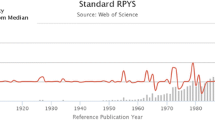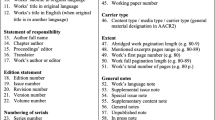Abstract
Citation impact indicators play a significant role in evaluating the scientific research activity. Most of citation impact indicators are based on the citation count that the publication is cited as a reference in the other publications, but the difference between each citation situation was not considered. Normally, the number of citations that a publication is cited in the other publications may represent the formal quality of the publication. Similarly, the number of times that a publication is really mentioned within the citing publication, it may also represent the formal quality of the citation. We have examined about how many times each reference was really mentioned within the citing publications and studied about the citation situation within the citing publications. We verified that the citation distribution of references according to the mention frequency follows the Generalized Pareto distribution. The results showed that about 20% of total references were mentioned three and more times, and the number of citation mentions for the about 50% of total references were from about 20% of the total references in the citing publications.


Similar content being viewed by others
References
Aksnes, D. W. (2003). A macro study of self-citation. Scientometric, 56(2), 235–246.
Arnold, D. N. (2009). Integrity under attack: The state of scholarly publishing. SIAM News, 42(10), 1–3.
Bertin, M., Atanassova, I., Gingras, Y., & Larivière, V. (2016). The invariant distribution of references in scientific articles. Journal of the Association forInformation Science and Technology, 67(1), 164–177.
Bollen, J., Rodriguez, M. A., & Van de Sompel, H. (2006). Journal status. Scientometrics, 69(3), 669–687.
Bornmann, L., & Daniel, H. D. (2008). What do citation counts measure? A review of studies on citing behavior. Journal of Documentation, 64(1), 45–80.
Bornmann, L., & Haunschild, R. (2016). Citation score normalized by cited references (CSNCR): The introduction of a new citation impact indicator. Journal of Informetrics, 10, 875–887.
Buela-Casal, G. (2004). Assessing the quality of articles and scientific journals: Proposal for weighted impact factor. Psychology in Spain, 8(1), 60–76.
Case, D. O., & Higgins, G. M. (2000). How can we investigate citation behavior? A study of reasons for citing literature in communication. Journal of the American Society for Information Science, 51(7), 635–645.
Ding, Y., Liu, X., Guo, C., & Cronin, B. (2013). The distribution of references across texts: Some implications for citation analysis. Journal of Informetrics, 7(3), 583–592.
Garfield, E. (1955). Citation indexes for science: A new dimension in documentation through association of ideas. Science, 122(3159), 108–111.
Garfield, E. (1972). Citation analysis as a tool in journal evaluation. Science, 178(4060), 471–479.
Garfield, E. (1996). How can impact factors be improved? British Medical Journal, 313, 411–413.
Garfield, E. (2006). The history and meaning of the journal impact factor. Journal of the American Medical Association, 295(1), 90–93.
González-Pereira, B., Guerrero-Bote, V. P., & Moya-Anegón, F. (2010). A new approach to the metric of journals’ scientific prestige: The SJR indicator. Journalof Informetrics, 4(3), 379–391.
Guerrero-Bote, V. P., & Moya-Anegón, F. (2012). A further step forward in measuring journals’ scientific prestige: The SJR2 indicator. Journal of Informetrics, 6(4), 674–688.
Hirsch, J. E. (2005). An index to quantify an individual’s scientific research output. Proceedings of the National Academy of Sciences of the United States of America, 102(46), 16569–16572.
Hirsch, J. E. (2010). An index to quantify an individual’s scientific research output that takes into account the effect of multiple co-authorship. Scientometrics, 85(3), 741–754.
Holsapple, C. W., Johnson, L. E., Manakyan, H., & Tanner, J. (1995). An empirical assessment and categorization of journals relevant to DSS research. Decision Support Systems, 14, 359–367.
Hu, Z., Chen, C., & Liu, Z. (2013). Where are citations located in the body of scientific articles? A study of the distributions of citation locations. Journal of Informetrics, 7(4), 887–896.
Hu, Z., Chen, C., Liu, Z. (2015). The Recurrence of Citations within a Scientific Article. In 15th international society of scientometrics and informetrics conference (pp. 221–229).
Maslov, S., & Redner, S. (2008). Promise and pitfalls of extending Google’s PageRank algorithm to citation networks. Journal of Neuroscience, 28(44), 11103–11105.
Massey, F. J. (1951). The Kolmogorov-Smirnov test for goodness of fit. Journal of the American Statistical Association, 46(253), 68–78.
Narin, F. (1976). Evaluative bibliometrics: The use of publication and citation analysis in the evaluation of scientific activity (pp. 184–198). Washington, DC: Computer Horizons.
Nisonger, T. E. (2008). The “80/20 rule” and core journals. The Serials Librarian, 55, 62–84.
Opthof, T. (2013). Inflation of impact factors by journal self-citation in cardiovascular science. Netherlands Heart Journal, 21, 163–165.
Pickands, J. (1975). Statistical inference using extreme order statistics. The Annals of Statistics, 3(1), 119–131.
Thelwall, M. (2016). Are the discretised lognormal and hooked power law distributions plausible for citation data. Journal of Informetrics, 10(2), 454–470.
Waltman, L. (2016). A review of the literature on citation impact indicators. Journal of Informetrics, 10(2), 365–391.
Waltman, L., & van Eck, N. J. (2013). A systematic empirical comparison of different approaches for normalizing citation impact indicators. Journal ofInformetrics, 7(4), 833–849.
Waltman, L., van Eck, N. J., van Leeuwen, T. N., Visser, M. S., & van Raan, A. F. J. (2011). Towards a new crown indicator: some theoretical considerations. Journal of Informetrics, 5(1), 37–47.
Wan, X., & Liu, F. (2014). WL-index: Leveraging citation mention number to quantify an individual’s scientific impact. Journal of the Association for Information Science and Technology, 65(12), 2509–2517.
Wilsdon, J., Allen, L., Belfiore, E., Campbell, P., Curry, S., Hill, S., et al. (2015). The metric tide: Report of the independent review of the role of metrics in research assessment and management bristol. Stoke Gifford: Higher Education Funding Council for England (HEFCE).
Yang, S., Lu, W., Zhang, Z., Wei, B., & An, W. (2016). Amplifying scientific paper’s abstract by leveraging data-weighted reconstruction. Information Processing and Management, 52, 698–719.
Zhao, D., Cappello, A., & Johnston, L. (2017). Functions of uni- and multi-citations: implications for weighted citation analysis. Journal of Data and Information Science, 2(1), 51–69.
Zhu, X., Turney, P., Lemire, D., & Vellino, A. (2015). Measuring academic influence: Not all citations are equal. Journal of the Association for Information Scienceand Technology, 66(2), 408–427.
Acknowledgements
This work was supported by the National Natural Science Foundation of China (Grant Nos. 71531013 and 71704035). Authors would like to express sincere thanks to the editors and reviewers of this paper.
Author information
Authors and Affiliations
Corresponding author
Rights and permissions
About this article
Cite this article
Pak, C., Yu, G. & Wang, W. A study on the citation situation within the citing paper: citation distribution of references according to mention frequency. Scientometrics 114, 905–918 (2018). https://doi.org/10.1007/s11192-017-2627-0
Received:
Published:
Issue Date:
DOI: https://doi.org/10.1007/s11192-017-2627-0




